Updated February 11, 2025 Authored by Dr. Chris Cloney and Jon Barrett of Dust Safety Science

Key Takeaways:
- Purpose of Combustible Dust Classification: The classification of combustible dust serves as a vital tool for assessing and managing the risks associated with its presence in industrial settings. It aims to provide a standardized framework for understanding the potential explosiveness and hazards associated with different types of combustible dust and combustible particulate solids in facilities.
- Importance of Combustible Dust Classification: The importance of combustible dust classification cannot be overstated in ensuring workplace safety across various industries. Accurate classification and Minimum Ignition Temperature provides the necessary groundwork for implementing targeted safety measures that address the specific risks associated with different types of combustible dust.
- Main Classifications, Groups, Zones, and Divisions, of Combustible Dust: The accurate classification and testing of combustible dust is integral to maintaining a safe working environment. By comprehending the purpose, classifications, influencing factors, and impact on safety practices, industries can proactively manage and mitigate the risks associated with combustible dust.
- Caution: Dust Can Still Be Explosive, Even If It Passes or Fails, Flammability Tests: Many combustible dusts can pass the United Nations (UN) flammability test but still be explosive in industrial settings. It’s crucial to not wrongly assume that dust is non-combustible just because it passes this test.
Table of Contents:
- What is Combustible Dust?
- Purpose of Combustible Dust Classification
- Main Classifications, Groups, Zones, and Divisions, of Combustible Dust
- Groups of Class II Locations, and Temperature Codes, with Combustible Dust
- International standards for dust explosion testing, ASTM E1226 and E1515
- KST Values/Deflagration Index, of Combustible Dust
- Explosibility of Different Combustible Dust Classes
- Pmax Values/Maximum Pressure of Combustible Dust
- Pressure Ratio (PR) of Combustible Dust
- Chemical Composition of Combustible Dust
- Accurate Testing Methods of Combustible Dust Classification
- Caution: Dust Can Still Be Explosive, Even If It Passes Flammability Tests
- Caution: Dust Can Still Be Explosive, Even If It FAILS Flammability Tests
- Conclusion
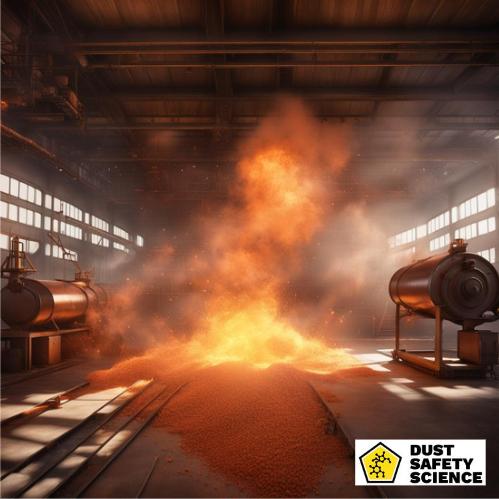
What is Combustible Dust?
Combustible dust refers to finely divided solid particles that are prone to ignition, such as static electricity, when suspended in the air. Examples of dust are powdered milk, wood dust, sugar dust, flour dust, metal dust, coal dust, rubber dust, and plastic dust, as by products of bulk material. These combustible dusts particles and by products can originate from various materials and equipment such as dust collectors, and processing equipment, and occur in agriculture, manufacturing, mining, and chemical processing. Although hazardous, silica dust and some other limited by products, are not a combustible dust. Dust accumulation and combustible particulate solids are created from these industry processes, including in a confined space, and creates a fire combustible dust hazard, or explosion hazard. The blanketing effect of layers of dust on the equipment that may cause overheating, and the ignition temperature of the dust. Static electricity may also be a factor in classifications for equipement.The damage combustible dust can cause can be catastrophic. In this section, we’ll delve deeper into what qualifies dust as combustible and why it poses a significant combustible dust hazard risk.
Dust qualifies as combustible when it possesses specific characteristics that make it prone to ignition and combustion when suspended in the air. These key attributes include particle size, concentration, and chemical composition. Fine particles, often smaller than 420 microns, are more likely to ignite due to their increased surface area. Additionally, a dust cloud must reach a certain concentration level in the atmosphere to become combustible. The composition of the dust is another crucial factor, as certain materials have inherently flammable properties. The Minimum Ignition Temperature Index, MIT, indicates the minimum temperature at which a hot surface will ignite a dust cloud or layer of dust after contacting it. For system elements such as dryers, testing the minimum ignition temperature is important to avoid a dust explosion through contact with a hot surface. Testing the minimum ignition temperature of other heat producing equipment is important, such as lighting fixtures or motors which could generate sufficient heat to ignite the surrounding atmosphere, and can ignite a dust cloud. Understanding these characteristics is vital for identifying and managing the risks associated with combustible dust, and ensuring workplace safety and compliance, and preventing a fire, combustible dust hazard, or explosion hazard.
Dust particles size influences a potential dust hazard. The fire triangle key three elements necessary for a dust explosion include fuel (the combustible dust), oxygen (present in the air), and ignition sources (typically a spark, open flame, static electricity, or even hot surfaces). The fire triangle represents the primary explosion. If one key element is missing from the fire triangle, such as open flames, then an explosion won’t occur. The addition of small particle, dust dispersion in a confined space, such as dust collectors, generates the Five factors (oxygen, heat, fuel, dispersion, and confinement) are known as the dust explosion pentagon. If one element of the dust explosion pentagon is missing, a combustible dust explosion cannot occur. Source: OSHA Combustible Dust Explosion

Purpose of Combustible Dust Classification
The classification of combustible dust serves as a vital tool for assessing and managing the dust explosion risks associated with combustible dust hazards in industrial settings. It aims to provide a standardized framework for understanding the potential explosiveness and hazards associated with different types of dust particles. Wood dust, sugar dust, flour dust, metal dust, coal dust, rubber dust, and plastic dust have different characteristics and may require dust hazard analysis and or testing of the dust. By understanding the specific properties of combustible dusts, and a possible combustible dust hazard companies can mitigate the risks of a dust cloud hazard, fires, and other safety incidents that may arise from their presence in manufacturing or processing facilities. Some equipment and factors include dust collectors, processing equipment, heat producing equipment, dust collectors, dust ignition proof electrical equipment, static electricity, and associated electrical conductivity, for classification.
Moreover, dust classification is a cornerstone for regulatory compliance and safety standards. Governments and regulatory bodies often mandate guidelines and regulations based on the classification of combustible dust to ensure workplaces adhere to specific safety protocols. This classification system provides a common language and framework for industries to communicate and implement necessary safety measures including dust ignition proof equipment and electrical equipment for combustible dust hazards. Electrically conductive particles can penetrate the openings in the equipment and cause an electrical failure. The blanketing effect of layers of dust on the equipment may cause overheating, and the ignition temperature of the dust, causing a combustible dust hazard. Effectively, these safety measures, including a dust hazard analysis, reduce the likelihood of combustible dusts accidents and promote a safer work environment for employees, and preventing a combustible dust hazard and combustible dust explosions. Examples of dust classification, such as division 1 and st 2, will be further explained in detail.
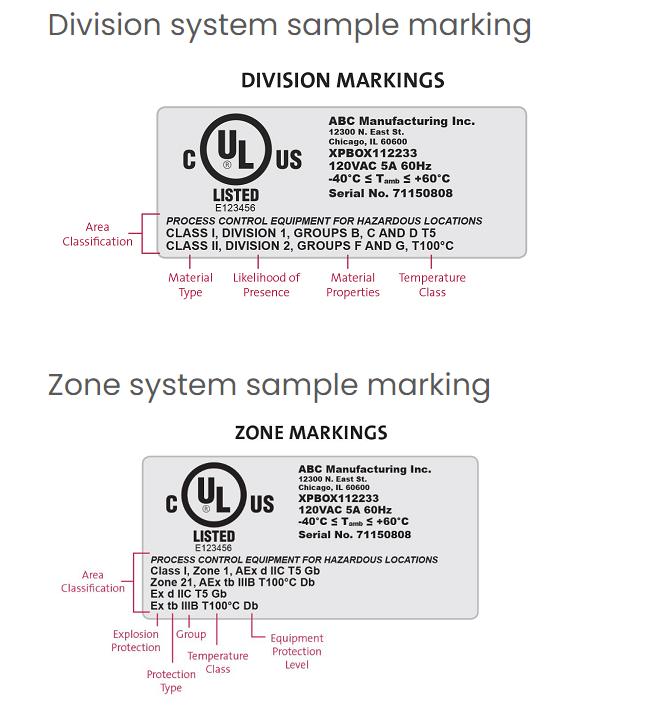
Main Classifications, Groups, Zones, and Divisions, of Combustible Dust
CLASS II LOCATIONS: COMBUSTIBLE DUST / HAZARDOUS SUBSTANCES
Class II locations are hazardous because of the presence of combustible dust. Note that the dust must be present in sufficient quantities for a fire or explosion hazard to exist, and may require a dust hazard analysis and or dust testing. The fact that there is some combustible dust present does not mean a Class II hazardous location exists. To be considered “dust”, the combustible material must exist as a finely divided solid of 420 microns (0.420 mm) or less. Such dust will pass through a No. 40 sieve. Just as in Class I, Divisions 1 and 2, the subdivision of Class II into Divisions 1 and 2 identifies the likelihood that there will be a combustible dust explosion hazard.
Division 1
Division 1 is an area where combustible dust can exist under normal, everyday operating conditions. Division 1 location is where combustible dust is normally in suspension in the air in sufficient quantities to produce ignitable materials, or where mechanical failure or abnormal operation of equipment might cause a fire or explosion or ignitable dust-air mixture to be produced, or where combustible dusts of an electrically conductive nature may be present in hazardous quantities (Group E). Regarding division 1, (Note – the term “hazardous quantities” is intended to mean those locations where the dust may not be in suspension in the air in sufficient quantity to cause a fire or explosion, but might have dust accumulation on electrical equipment so that the electrically conductive particles can penetrate the openings in the equipment and cause an electrical failure.)
Division 2
Division 2 is regarding a location where combustible dust is not normally in the air in sufficient quantity to produce an explosion, and dust accumulations are not normally sufficient to interfere with the normal operation of electrical equipment. It includes locations where combustible dust may be in suspension in the air only as a result of infrequent malfunctioning of handling or processing equipment, and those locations where dust accumulation may be on or in the vicinity of the electrical equipment and may be sufficient to interfere with the safe dissipation of heat from the equipment, or maybe ignitable by abnormal operation or failure of the electrical equipment. As a result, a fire or explosion hazard, or dust explosions may occur.
Groups of Class II Locations, and Temperature Codes, with Combustible Dust
National Fire Protection Association 660 emerges as a response to the pressing need for a unified approach to combustible dust safety. The Combustible Dust Document Consolidation Plan, approved by the NFPA Standards Council, lays the groundwork for the development of the National Fire Protection Association, NFPA 660. This consolidation plan by the National Fire Protection Association NFPA, integrates key standards, streamlining guidelines, and best practices into a single, comprehensive document.
By consolidating standards such as NFPA 61, which focuses on agricultural and feed processing facilities, and NFPA 654, which addresses manufacturing and handling of combustible particulate solids, NFPA 660 ensures that industries have access to relevant and practical guidance tailored to their specific operations.
Key Components of NFPA 660
Class II locations are divided into three groups E, F, and G. Class II location groups are determined by: the ignition temperature of the dust, the electrical conductivity of the dust, and the thermal blanketing effect the dust can have on electrical equipment, and heat producing equipment such as lighting fixtures and motor bearings.
Group E
Group E dusts include metal dust, such as aluminum and magnesium. In addition, these group E dusts are highly abrasive and thus likely to cause overheating of motor bearings, mechanical failure, and electrical failure, if the combustible dusts gets into the bearing. Group E dusts are electrically conductive and if they are allowed to enter an enclosure, they can cause electrical failure of the equipment
Group F
Group F dusts are carbonaceous, the primary dust in this group being coal dust, (*also coal dust and carbon black). These coal and carbon black dusts have somewhat lower ignition temperatures than the Group E dusts and a layer of Group F dust has a higher thermal insulating value than the layer of Group E dust, thus requiring a more careful control of the temperature on the surface of the material. Such dusts are semi-conductive but this is not usually a factor for equipment rated 600 volts and less.
Group G
Group G dusts include combustible material such as plastic dust, most chemical dust, food, and grain dust. They are not electrically conductive. These combustible dusts, in general, have the highest thermal insulating characteristics and the minimum ignition temperatures. Thus dust-ignition proof equipment for use in Group G atmospheres must have the lowest surface temperatures to prevent ignition of a layer by the heat producing equipment.
Temperature Codes (T-Codes)
The ignition temperature or auto-ignition temperature (AIT) is the minimum auto ignition temperature required to initiate or cause self-sustained combustion in a substance without any apparent source of ignition. The lowest published ignition minimum temperature should be the one used to determine the acceptability of equipment. This is of particular concern when selecting heat producing equipment such as lighting fixtures or motors that could generate sufficient heat to ignite the surrounding atmosphere. Class I and Class II areas use T-Codes or are subject to maximum temperature limitations. North America and the IEC are consistent in their temperature or T-Codes. However, unlike the IEC, North America includes incremental values as shown. Equipment tested must have nameplates and marks showing class, group, and operating temperature based on operation in a 40 ° C ambient (see NEC 500-3 for exceptions). Non-heat producing and non heat generated equipment does not have this requirement.
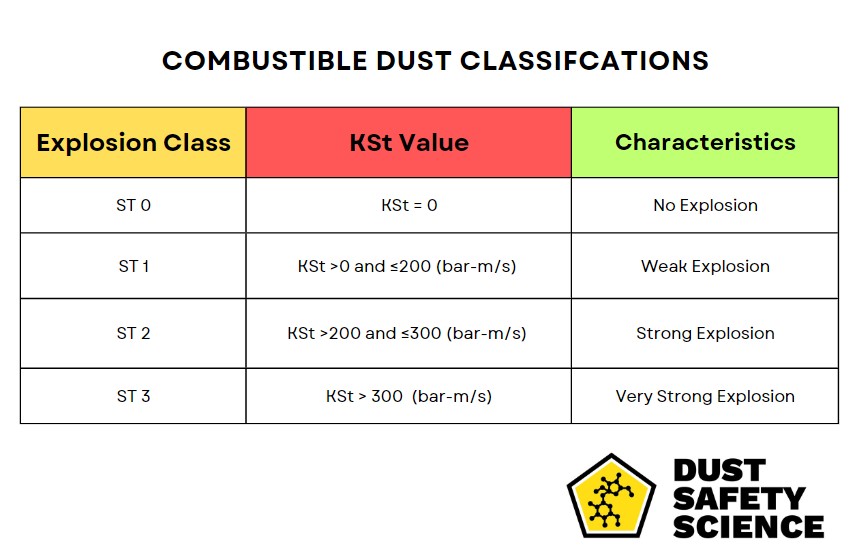
International standards for dust explosion testing, ASTM E1226 and E1515
The international standards for dust explosion testing are ASTM E1226 and E1515, which govern how to determine:
- KST: The size-normalized maximum rate of pressure rise under standard testing conditions
- Pmax: The maximum pressure from an explosion in closed vessel conditions.
The American Society for Testing and Materials, ASTM E1226-19, and ASTM E1515-14 are the most common standards used for Deflagration testing in North America, and are further detailed, in the next sections:
KST Values/Deflagration Index, of Combustible Dust
KSt = Kmax*V^(1/3), where V (volume) is in meters and Kmax is bar/s
Kst values, represent the dust deflagration index, categorizing dust based on its explosibility and combustion characteristics. These values help in classifying dust into various categories, determining the severity of potential explosions, and guiding risk assessment procedures.
The main classifications of combustible dust predominantly revolve around Kst values and dust classes, both crucial in assessing the explosibility and severity of potential hazards within industrial environments. Kst values, essentially the dust deflagration index, serve as a pivotal metric in categorizing combustible dust. These values provide a standardized means to gauge various dust types’ explosibility and combustion characteristics. The classifications derived from Kst values aid in determining the potential severity of explosions, thereby guiding risk assessment procedures and helping industries implement appropriate safety measures tailored to the specific hazards of different dust materials.
Combustible types of dust are divided into four classes: St 0, St 1, St 2, and St 3. A high Kst value will rank highly on the class scale, indicating a potential explosion. Similarly, a Kst value of 0 means zero risk of a dust explosion and explosion hazard, which represents silica dust. The only dust that has zero risk of explosion is an ST0 dust. St 2 dust may include some metal dusts. St 2 Dust may also include some plastic dusts.
- St 0: Kst value 0 – no explosion. Typical of silica dust, welding-generated dust, and thermally generated dust (from cutting processes, for example).
- St 1: Kst value >0-200 (bar-m/s) – weak explosion. Typical of charcoal, powdered milk, sugar, sulfur, wood dust, and zinc.
- St 2: Kst value >200-300 (bar-m/s) – strong explosion. Typical of cellulose, wood flour, poly methyl acrylate (PMA).
- St 3: Kst value >300 (bar-m/s) – very strong explosion. Typical of metal dusts such as zirconium, aluminum, magnesium, and titanium.
Overall, the dual classifications of Kst values and dust classes provide industries with a structured framework to evaluate the explosibility and hazards associated with combustible dust. This understanding is crucial for risk management strategies, enabling businesses to prioritize safety measures, mitigate potential dust clouds and a dust explosion, and foster a safer working environment by tailoring safety protocols according to the specific explosibility characteristics of different dust materials.
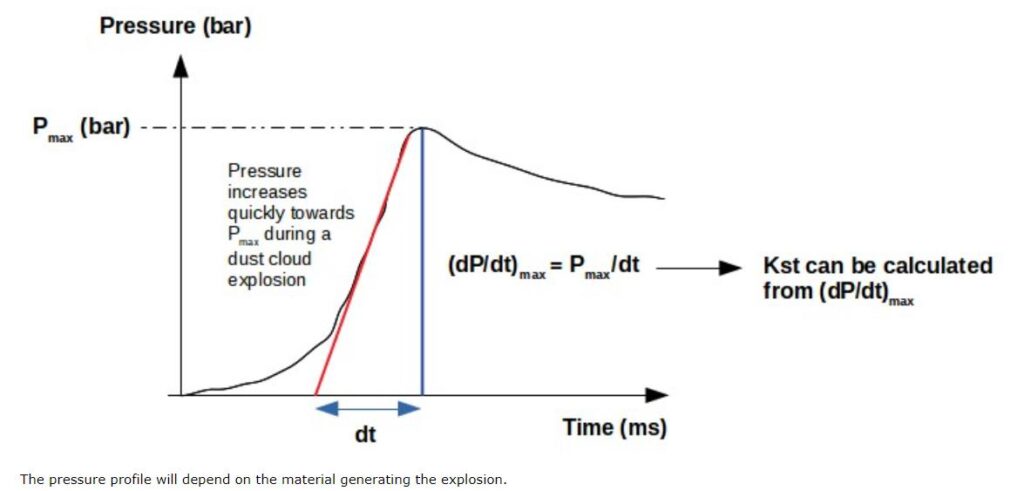
Explosibility of Different Combustible Dust Classes
Dust classes, ranging from St-1 to St-3, signify varying degrees of explosibility. St-1 indicates a lower explosibility potential, whereas St-3 represents dust with high explosibility, highlighting the importance of understanding the risks associated with different classifications.
The explosibility of different dust classes is denoted by a range from St-1 to St-3, each representing varying degrees of explosibility potential. St-1 classification indicates dust with a lower potential for explosibility, while St-3 signifies dust with high explosibility. Understanding these dust classes is vital in comprehending the risks associated with different types of combustible dust. Dust classes such as st 0, st 1, st 2, and st 3, emphasizes the need for thorough assessment and preventive measures in handling, processing, and storing materials falling under each classification. Industries must recognize and differentiate between these classes to appropriately manage the risks and implement safety protocols commensurate with the explosibility level of the dust present in their facilities. Some examples of dust classes such as st 0, st 1, st 2, and st 3 are shown in the digital image from NFPA below.
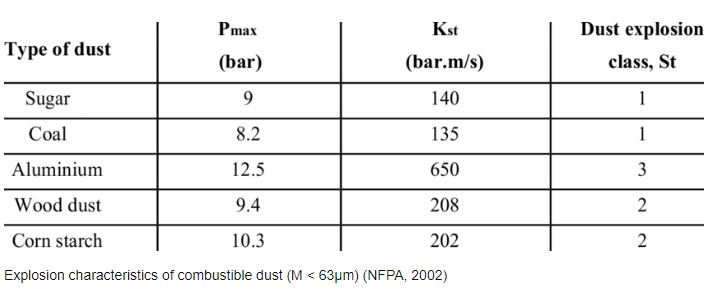
Pmax Values/Maximum Pressure of Combustible Dust
The term Pmax refers to the maximum amount of pressure generated during a dust deflagration and damage combustible dust can cause in a confined space. This measurement allows you to understand the potential damage dust can create in a confined space. The higher the pressure (Pmax) developed by dust deflagration, the greater the hazard. The pressure resulting from a deflagration in a vessel will first result in deformation, followed by an explosion, if the Pmax exceeds the strength of the vessel.
This parameter is determined through laboratory testing and is indicative of the explosive power of the dust. The significance of Pmax lies in its use for categorizing dust as either deflagration-dusts or detonation-dusts, helping industries and regulatory bodies classify and manage the associated combustible dust hazard risks.
Different combustible dusts have varying Pmax values, and these values play a crucial role in the design and implementation of safety measures. Industries handling combustible dust must conduct thorough risk assessments to identify the types of dust present, their respective Pmax values, and the conditions under which deflagration could occur. This information is instrumental in designing and implementing effective explosion protection systems, such as venting, suppression, and containment measures.
Understanding the Pmax values of combustible dust is essential for managing the associated risks and implementing effective safety measures. This knowledge enables industries to categorize and mitigate the combustible dust explosion hazards, posed by different types of dust, contributing to a safer working environment and overall workplace safety compliance.
Pressure Ratio (PR) of Combustible Dust
The PR of a dust cloud compares the maximum pressure occurring during the test deflagration to the initial atmospheric pressure measured before ignition. The maximum pressure is adjusted for the rise due to the igniter in the air at atmospheric pressure. Traditional values for determining if a material is explosive (ignition criterion) use a minimal value of PR ≥ 2.0
The Pressure Ratio (PR) of combustible dust is a crucial parameter used to assess the explosiveness of a dust cloud during a deflagration test. This ratio is determined by comparing the maximum pressure generated during the test deflagration to the initial atmospheric pressure measured before ignition. It is essential to account for the rise in pressure caused by the igniter in the air at atmospheric pressure. The PR provides insights into the force exerted by the combustible dust when ignited, helping to gauge the potential risk and explosiveness of the material.
In the context of assessing whether a material is explosive, the ignition criterion relies on traditional values of PR. A commonly accepted threshold is set at a minimal value of PR ≥ 2.0. This criterion acts as a safety measure, indicating that materials with a Pressure Ratio equal to or exceeding 2.0 are considered potentially explosive. The use of this criterion serves as a standard for evaluating the hazardous nature of combustible dust, assisting in the development of safety protocols and preventive measures to mitigate the combustible dust explosions and risks associated with dust deflagrations in industrial settings.
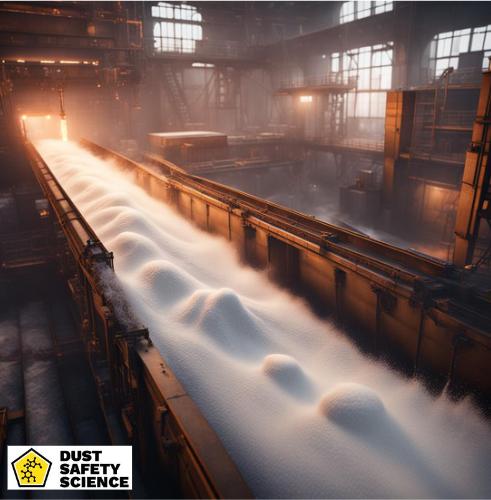
Factors Determining Dust Classification
Particle Size and Shape
Several factors impact the classification of combustible dust, particle size, and shape, hold significant importance. The size and shape of dust particles greatly impact their surface area and reactivity. Finer particles with increased surface area-to-mass ratios tend to be more combustible and prone to rapid combustion or combustible dust explosions. Therefore, precise measurement and evaluation of particle size and shape are critical in assessing the potential fire or explosion hazard, posed by combustible dust, and combustible dust explosions, aiding in its accurate classification and the implementation of appropriate safety measures.
Moisture Content
Moisture content is another essential factor influencing dust classification. The presence of moisture within dust can significantly affect its combustibility. The presence of moisture in dust can mitigate its combustibility. Dust with higher moisture content might be less prone to ignition, affecting its classification and potential hazards. Dust materials with higher moisture content may exhibit reduced flammability and ignition potential compared to dry dust. The moisture acts as a mitigating factor, altering the dust’s combustibility characteristics and subsequently affecting its classification and extent of dust explosions.
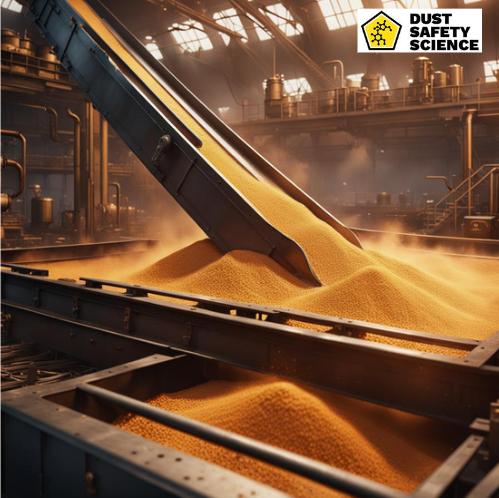
Chemical Composition of Combustible Dust
The composition of combustible dust is a pivotal determinant in its classification and poses a significant impact on the risks associated with combustible dust in industrial settings. Various substances exhibit distinct levels of combustibility, which directly influence the potential hazards and explosibility of the dust. Some substances are highly reactive and prone to ignition, while others may exhibit lower combustibility characteristics. The composition of dust plays a crucial role in its classification. Different substances have varying levels of combustibility, influencing the overall risk assessment and safety precautions. Understanding the composition of dust is imperative for accurate classification and for implementing tailored safety measures commensurate with the specific risks posed by different substances.
Different compositions present in dust materials can lead to varying combustion behaviors and ignition potentials. For instance, organic materials like wood, flour, sugar, or certain metals in powder form can be highly combustible, catch fire, and cause a devastating dust explosion. Conversely, inorganic substances such as minerals or certain non-metallic compounds may have lower combustibility tendencies for dust explosions. Analyzing the composition aids in identifying the inherent risks associated with different types of combustible dust, enabling industries to assess and manage potential hazards effectively by adopting appropriate safety protocols and preventive measures based on the specific properties of the materials present.
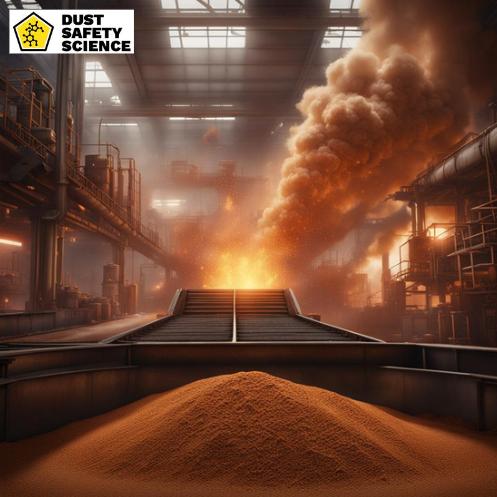
Accurate Testing Methods of Combustible Dust Classification
Importance of Accurate Testing Methods of Dust Classification
The importance of accurate testing methods impacts dust classification on safety practices within industrial settings is profound, significantly shaping risk assessment methodologies and safety protocols.
Accurate testing and classification of combustible dust materials are pivotal in determining the level of combustibility of different dust types, providing crucial insights that inform the development of tailored safety measures. This understanding serves as a linchpin for conducting comprehensive hazard analyses, enabling industries to identify specific risks associated with combustible dust, and dust explosions, and implement preventive measures effectively. Understanding the combustibility level of dust aids in developing tailored safety protocols, conducting thorough hazard analyses, and implementing preventive measures to mitigate potential fire or explosion hazard risks.
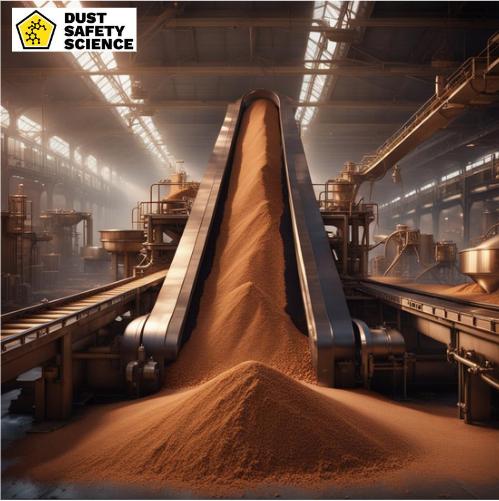
Caution: Dust Can Still Be Explosive, Even If the Dust Passes Flammability Tests
Many combustible dusts can pass the United Nations (UN) flammability test but still be explosive in industrial settings. It’s crucial to not wrongly assume that dust is non-combustible just because it passes this test. Making this mistake could mean skipping necessary safety assessments, like a dust hazard analysis, which could lead to dangerous situations, including explosions.
The UN test for flammable solids is detailed in their recommendations for transporting dangerous goods. It aims to identify materials that can ignite and burn quickly or violently. The test has three parts: a preliminary screening, a burn rate test, and a wetted zone test. In the preliminary test for organic materials, you form a strip of powder on a heat-resistant surface and apply a flame for up to two minutes. If the powder doesn’t burn along its length in this time, it’s not considered a flammable solid, and no further tests are needed. If it does ignite, you proceed to the next tests.
The burn rate test uses a V-shaped mold to see how fast the material burns. The wetted zone test checks if burning can continue past a damp area. These tests help classify the burning characteristics of a material. For metals and other materials, the requirements are slightly different.
In summary, the UN test starts with the preliminary screening, where a strip of powder is exposed to a flame. If the material doesn’t burn, it’s not classified as a flammable solid according to the standard.
When a material passes the preliminary UN screening test and is labeled as non-flammable, it raises the question: does this mean the material can’t explode as combustible dust? To answer this, let’s look at the ASTM E1226 test method, which is the standard for testing the explosive potential of dust clouds. This method measures the maximum pressure and rate of pressure rise in a combustible dust sample. It uses a 20-liter sphere, where dust is blown in and ignited to see if it explodes at certain concentrations and under specific conditions. The ASTM standard includes a basic pass/fail screening test, but it warns that just because a material doesn’t explode in this test, it doesn’t mean it’s not flammable.
Caution: Dust Can Still Be Explosive, Even If the Dust FAILS Flammability Tests
Interestingly, some materials that fail the UN flammability test can still be explosive as dust. For example, sugar might not catch fire in a pile and would fail the UN test, but sugar dust is known to catch fire and be explosive, as seen in several sugar refinery explosions. Other materials like Cornstarch and Lycopodium also might fail the UN test but are still explosible.
Some examples and test data showing that some materials classified as non-explosive in the ASTM screening test could still be flammable. This shows that the UN test for flammability might not always be a reliable indicator of a material’s explosive potential as dust.
In a test using the ASTM E1226 standard, fermented soybean meal showed significant explosive potential. The test results indicated a maximum pressure of 7-8 bar and a maximum explosion severity (KST) of around 130 bar meters per second, classifying it as a moderately explosive material. This means it could cause injuries or equipment damage in a flash fire or explosion. However, the same soybean meal failed the UN flammability test. It didn’t propagate a flame in the preliminary strip or V mold tests. During the burn rate test, it glowed but didn’t burn enough to be considered flammable. This example illustrates how a material can be non-flammable under one test method but still highly explosive under another.
The flammability test is based on the long-term reaction kinetics and heat transfer mainly through conduction. This involves how a material burns over a longer period and how heat moves through a pile of dust. The explosibility test, however, works differently. It involves dust particles suspended in the air with significant space between them, leading to different reaction dynamics. This means that the conditions and mechanisms in explosibility tests are entirely different from flammability tests, explaining why a material might fail to burn as a solid but still explode as dispersed dust.
When discussing an optically thick medium like a dust cloud, we refer to its opacity as light. Imagine a simple experiment where a light bulb or lighting fixtures are obscured by a wood dust cloud; the light doesn’t pass through, indicating the cloud’s density. However, this wood dust cloud is largely composed of air interspersed among the particles. The combustion process within such a dust cloud is unique and complex. It begins with a single particle igniting and reacting at an incredibly fast rate, in a matter of microseconds to milliseconds. This rapid reaction is influenced by various factors, such as the rate at which the particle releases volatile compounds or its heating rate, as well as the kinetics of the reaction itself.
The blanketing effect of layers of dust on the equipment that may cause overheating, and the ignition temperature of the dust. Once a particle ignites, it heats the surrounding air and particles through convection or radiation. If the initial reaction is intense enough to heat the neighboring particle sufficiently for it to ignite before the first burnout, a chain reaction ensues, with a fire or explosion. This propagation of reaction and flame through the dust cloud happens at a microscale – far quicker than seconds or minutes, causing a dust explosion. It’s not just a matter of whether the material reacts, but also how the energy is released and dust particles dispersed during the reaction, with a dust cloud, and static electricity in confined space, causing a dust explosion hazard.
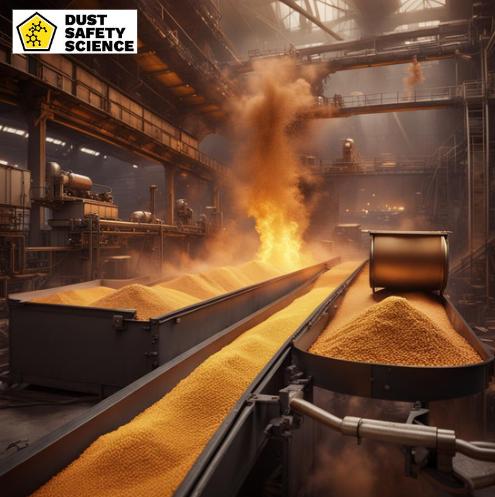
Conclusion
The accurate classification and testing of combustible dust and combustible dust materials is integral to maintaining a safe working environment, and to prevent a flash fire and a dust explosion. Accurate classification and Ignition Temperature criteria are required when selecting heat producing equipment such as lighting fixtures or motors. By comprehending the purpose, classifications, influencing factors such as minimum temperature, static electricity, and impact on combustible dust safety practices, industries can proactively manage and mitigate the flash fire or explosion risks associated with electrical equipment combustible dust particles, and a dust explosion. The damage combustible dust can cause can be catastrophic. Combustible dust safety awareness of the National Fire Protection Association NFPA, ATEX and UL standards and codes, classifications, and divisions, ensures the well-being of workers and compliance with safety regulations. This comprehensive knowledge not only ensures the well-being of workers but also ensures compliance with safety regulations, fostering a workplace culture that prioritizes safety and minimizes potential hazards related to combustible dust in industrial settings. Extreme caution will be required, as dust can still be explosive, even if the dust passes or fails flammability tests. Sometimes static electricity can be a root cause of a dust explosion.
About Dust Safety Science
Dr. Chris Cloney, of Dust Safety Science, provides additional Combustible Dust information, with a Podcast. Click on the latest Podcast Link: Can A Non-Flammable Dust Explode?
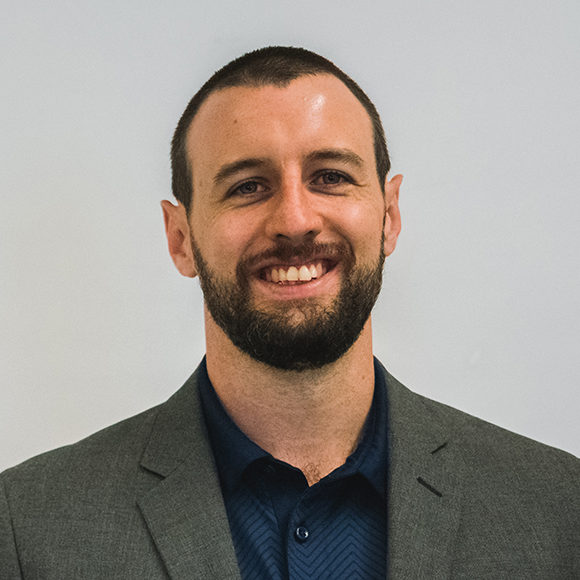
Resources:
Visit Dust Safety Science (Global Incident Tracking)
Visit Dust Safety Academy (Resources, Training and Events)
Visit Dust Safety Professionals (Need Help? Get Support Today!)
Visit Dust Safety Journal for the Dust Safety Science Monthly Journal
Subscribe to our Dust Safety Science Newsletter at Dust Safety Science Newsletter
Visit the Dust Safety Science blog for written articles on combustible dust safety including the latest research, expert opinions, and state-of-the art in fire and explosion protection.
